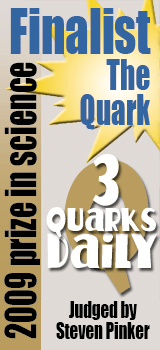Scientia Pro Publica 17: The EPIC Edition
Welcome to the Epic edition of Scientia Pro Publica (a.k.a. the edition that almost didn’t happen). What makes this edition epic? Well, we do—we said it would be epic so it’s epic—but more importantly, the awesomeness of the science bloggers in this edition has reached truly epic proportions. Due to a SNAFU with the automated submission form, we only had one submission going into the weekend. A one-post carnival just isn’t “epic” so we begged our fellow science bloggers to re-submit their posts over the weekend. As you can see, they came through with epic awesomeness…
Anthropology/Evolution/Raptors are cool
In Projectile weapons and carnivores, DeLene reports on a Duke University scientist’s theory that projectile weapons (and the ability to throw them) enabled modern humans to out-compete Neanderthals and kill off all of Europe’s large carnivores.
Eric Michael Johnson of The Primate Diaries writes that Ardipithecus is not a missing link! He says that referring to Ardipithecus as a “missing link” (as many media outlets have done) is “like referring to a medical breakthrough in the treatment of lung disease by using Galen’s view that it caused a “reduction of phlegmatic humours” in the chest.”
Did you know that most raptors kill their prey by constriction? This is just one of the cool things I learned from John Beetham’s post about how raptor talons fit their prey. Apparently, some raptors kill their prey by striking them at high speed and some merely hold their prey still (while the prey is alive) as they pluck and eat it. One more cool raptor fact: falcons have a tooth-like projection on their beaks.
Conservation and Management
Jeremy tells us how not to manage overfishing in Law of unintended consequences, coconut edition. To give fishermen an alternative source of income (and hopefully reduce pressure on the country’s reef fish), the government of Kiribati subsidized the coconut oil industry. It didn’t work out the way the government planned…
Mike introduces us to a new way to count birds in Counting Birds: will microphones replace nets? He reports that ecologists have developed a system that uses birdsong to estimate the size of bird populations.
Gunnar Engblom reports that DNA from Darwin’s expedition may help save the critically endangered Floreana Mockingbird in Floreana Mockingbird Restoration.
In A New Look, I wrote about our new doormat and how it’s (kinda) protecting North Atlantic right whales and (sorta) helping Maine lobstermen.
Marine Science
DeLene writes about a recent study that examined the effects of ocean acidification on shelled marine organisms in Acid ocean test looks to the past. Under the experimental conditions, some critters responded predictably (with thinner shells), while others perplexed researchers by growing thicker shells in the more acidic seawater.
In lighter marine science news, Christina takes us on a virtual aquarium tour (that includes dogfish sex) in Fishy Fridays and Heather describes the mysteries of hydrothermal vents.
Plants/Agriculture
GrrlScientist writes about the discovery of the world’s smallest orchid species—the petals of the teeny tiny flower are only one cell thick, making the flower transparent—while Jeremy, from Agricultural Biodiversity asks: Do farmers know how to save seeds?
Chemistry/Biochemistry
Using a picture of a duck and a picture of a cat, S. Gould explains how Fourier transformations can be used to determine structures in protein crystallography in Lab Rat guide to Fourier Transformations. In a completely unrelated post, Lab Rat writes about using microbes to make second generation biofuels.
Heather explains that processing DNA is more complicated than the CSI team makes it look in A (hopefully) comprehensible explanation of something complicated…or why DNA is hard to read.
Medicine Past and Present
Romeo Vitelli has a new toy—a vintage Davis & Kidder Patent Magneto-Electric Machine for Nervous Diseases. According to Dr. Vitelli, the machine was quite popular in its day. It was used for medical purposes (to treat asphyxia, asthma, angina, impotence, constipation, “critical periods or turn of life in females” and diabetes) and for fun (at “phosphene parties” a group of people joined hands in a circle while touching the machine). Learn more in Singing the body electric.
In honor of Celiac Awareness Month (October), Eric R. Olson shares a profile of celiac disease. Many celiac patients choose to forgo formal testing for the condition…which brings us to Bora Zivkovic’s post about the importance of storytelling in medicine. In Lisa Sanders at UNC, we learn that physicians who interview a new patient correctly diagnose them after just an interview 75-80% of the time.
Reviews
It’s hard to stay up-to-date on the latest books about science and the environment. My co-blogger, Peter, recently reviewed Cradle to Cradle, a book that’s been out since 2002. His verdict: read it or stuff it in your favorite scientist’s stocking.
That’s it for the epic edition. The next edition of Scientia Pro Publica will be hosted by Bob O’Hara (assisted by GrrlScientist) at the hibernating blog, Deep Thoughts and Silliness on December 21. We’ll keep you posted on the status of the automatic submission form, but email submissions are always welcome (ScientiaBlogCarnival@gmail.com).
Trackbacks
- Science for the public – Research for dummies | A birding blog by Gunnar Engblom
- Scientia Pro Publica is EPIC [The Primate Diaries] « Random Information
- Nibbles: Monsanto, Carnival, Recycling
- Scientia Pro Publica 17
- Nature Blog Network » Friday Roundup: December 11, 2009
- M2M’s Top 10 of 2009 « Mauka to Makai
- Scientia Pro Publica Has Been Published! | This Scientific Life






Thanks so much for including our links from Science in the Triangle! Now I’m off to read about those fascinating hydrothermal vents you mentioned…